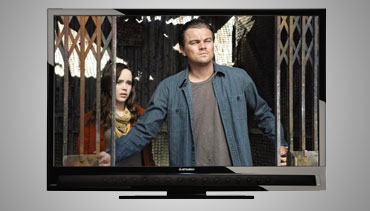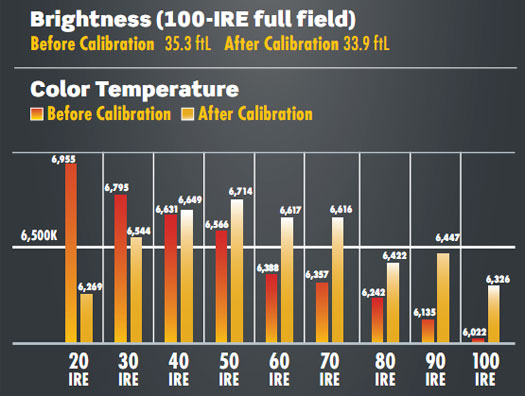Test Report: Mitsubishi LT-46265 LCD HDTV Page 4


Color temperature (Natural mode/Low color temperature preset before, Advanced 2 mode after):
20-IRE: 6,955 K/6,269 K
30-IRE: 6,795 K/6,544 K
40-IRE: 6,631 K/6,649 K
50-IRE: 6,566 K/6,714 K
60-IRE: 6,388 K/6,617 K
70-IRE: 6,357 K/6,616 K
80-IRE: 6,242 K/6,422 K
90-IRE: 6,135 K/6,447 K
100-IRE: 6,022 K/6,326 K
Brightness (100-IRE): 35.3/33.9 ftL

The Mitsubishi LT-46265's Natural mode delivered the most accurate picture of its five presets, measuring within +/-365 kelvins through most of its grayscale (30 to 90 IRE) when the Low color temperature preset was also selected. Performance improved to +/-214 kelvins from 30 to100 IRE after calibration in the set's Advanced 2 mode.
Color-decoder error via the set's HDMI inputs measured +12.5% for red - something that showed up during regular viewing - and its primary color points closely matched the SMPTE HD standard in Natural mode. Using the comprehensive set of color-management system controls in the Advanced picture menu, I was able to successfully remove the red-push. Gamma at the target 2.2 setting averaged 2.4 in Natural mode. Brightness measured from a 0 IRE full-field pattern in Advanced mode (post-calibration) was 0.016 ftL, with 33.9 for 100 IRE, resulting in a contrast ratio of 2118:1.
Overscan was 0% with the 1080i/p Full Native picture format selected, while the 1080i/p Standard format displayed 6% overscan. The set showed full picture resolution with all signal formats delivered via both HDMI and component-video connections. Motion-resolution tests revealed 1,080 lines with the True 240 Hz Motion Blur adjustment at its midpoint setting, and 600 lines when that mode was turned off.
The Mitsubishi scored poorly on both screen-uniformity and viewing-angle tests: Both "clouding" and "spotlights" could be seen on a 10-IRE full-field pattern, while viewing angle was limited to around 10º off from a center seat. It passed most of the tests contained on the various high-def video evaluation Blu-rays I checked out, properly deinterlacing both film- and video-sourced material. (The main tests it tripped on were the ones that evaluate handling of 2:2 pulldown for standard- and high-definition signals.) Noise-reduction processing was very effective, with no picture-detail loss visible even with the Video Noise mode at its High setting. -A.G.
- Log in or register to post comments




















































